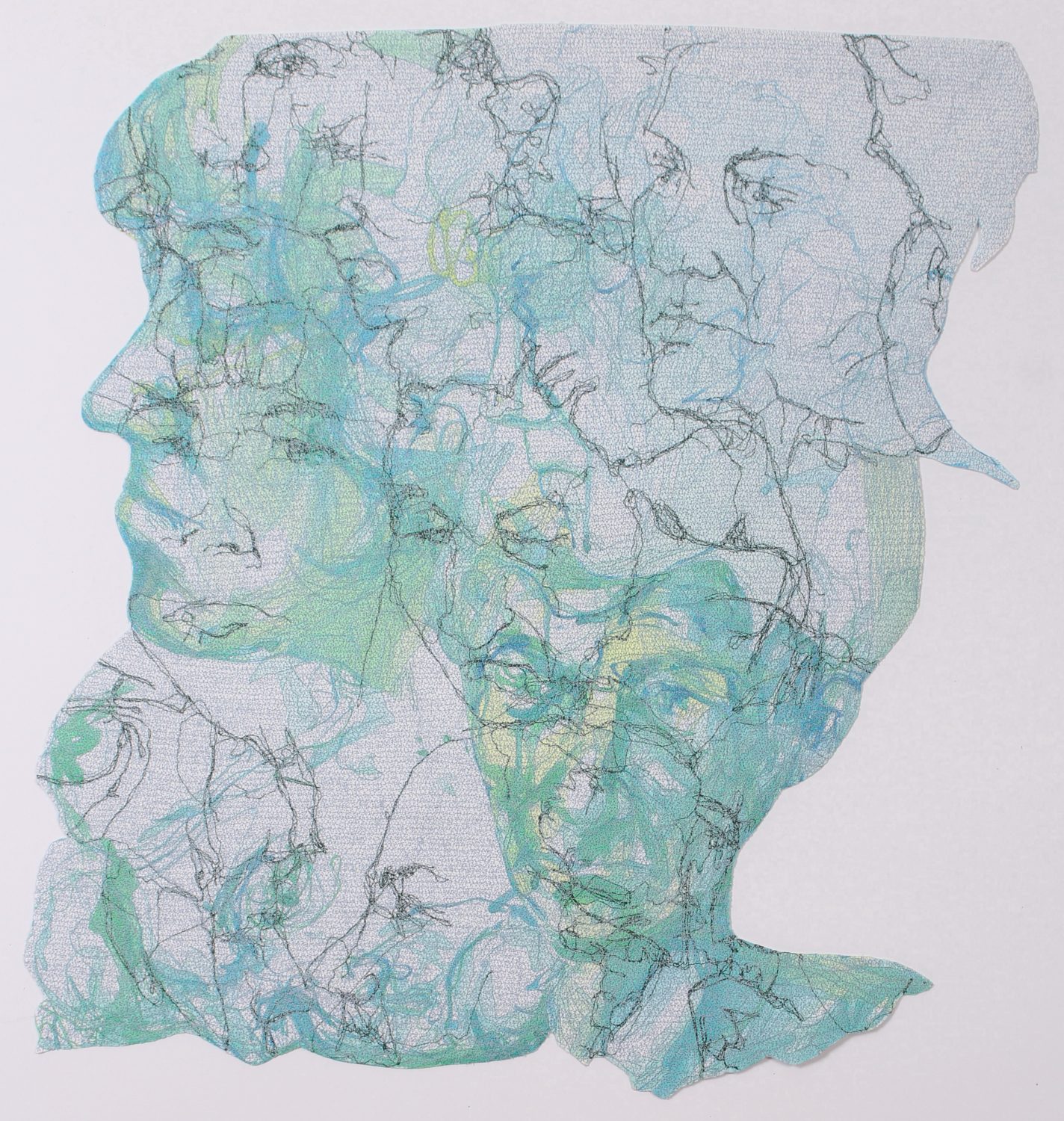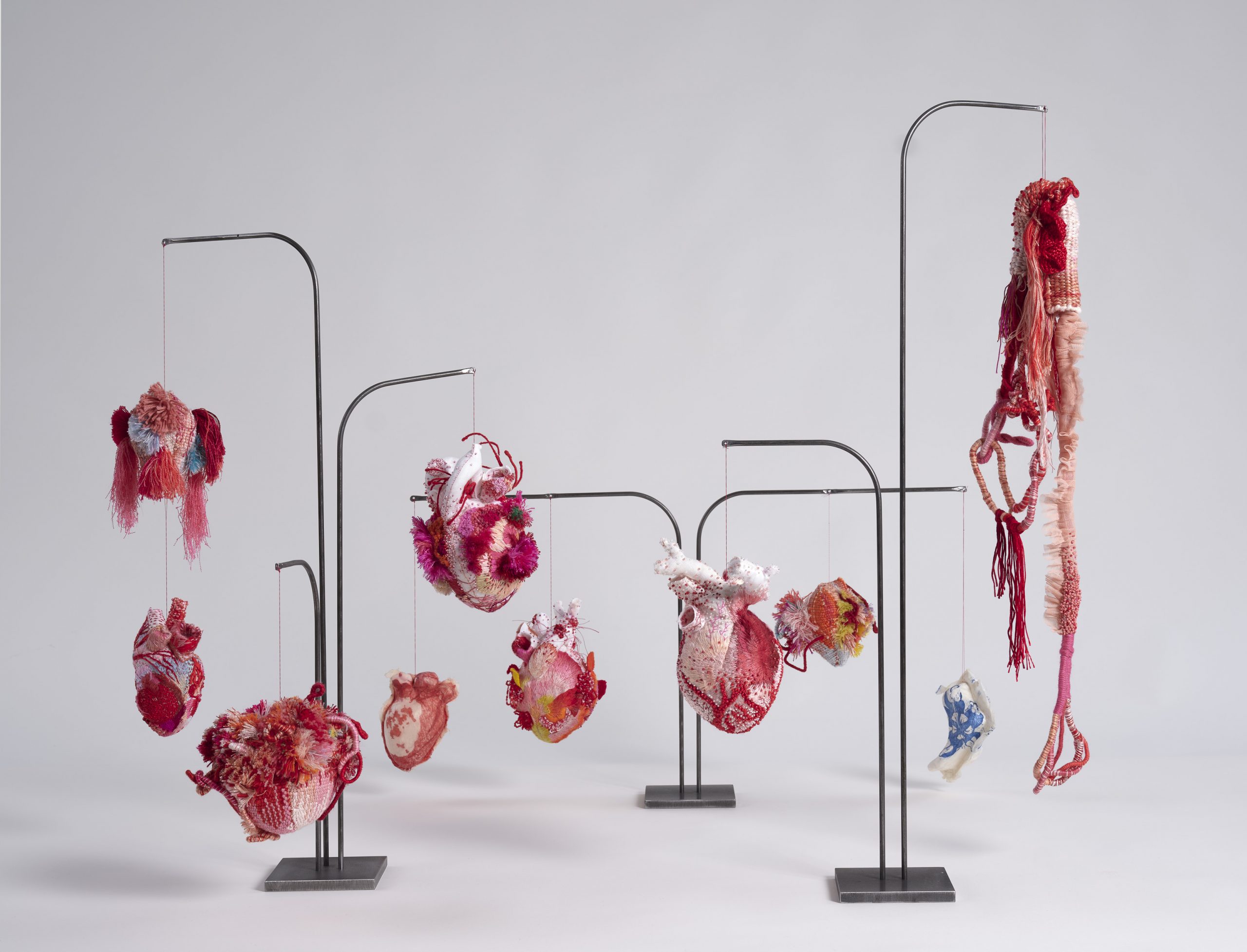Every year, Hand & Lock organizes a competition for the prestigious Prize for Embroidery to promote the use of hand embroidery and to discover emerging embroidery talent. The 2019 brief, “Fool the Senses,” invited entrants to consider the texture and feel of embroidery. Projects focused on embellishments with sumptuous surfaces that intrigued and surprised as they to deceived, confused, and fooled the senses. Organizers encouraged artists to recycle and re-purpose old materials, re-imagining and transforming them into something new.
London’s Bishopsgate Institute hosted the final judging and award ceremony, showcasing 24 finalists’ masterpieces organized into four categories: textile works by students and textile works non-students, fashion by students and fashion by non-students. A separate display featured notable works pre-selected for associate awards by Hand & Lock’s partners.
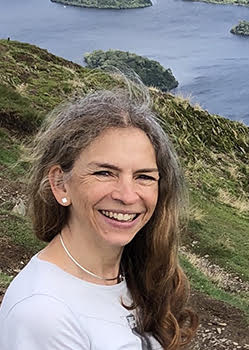
Today we’ll meet the third-place winner in the Open Textile Art category, Julie Heaton.
Location: Bristol
Website: julieheaton.com
The Competition
Describe your Hand & Lock entry and what motivated it:
I draw with rayon thread on 2 layers of dissolvable fabric. I control my making with obsessive attention to detail, constantly changing threads and tensions sometimes for only 2 stitches. I make mistakes, remove them and try again in the attempt to get a perfect piece of art. In the final stage of this process all control is lost; I wash away the supporting fabric and the threads move around finding their own place in the work. I love this uncertainty, spending hours and hours making a drawing that might end in a pile of threads.
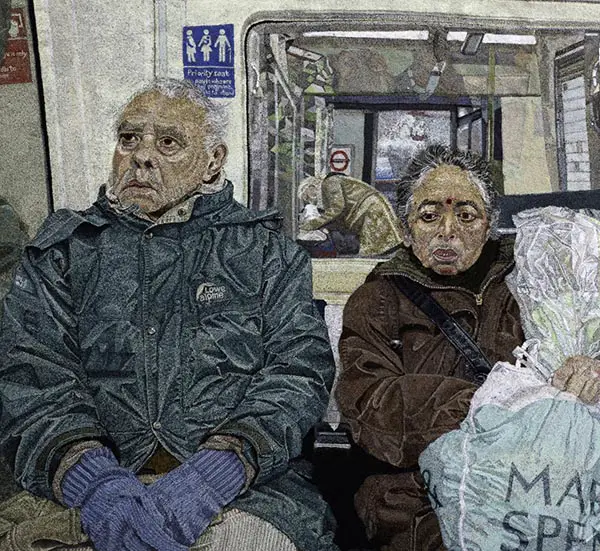
In 2014, I took the photograph of the unknown couple on a busy tube train in London. The couple fascinated me, they didn’t move, engage with each other or anyone else on the tube and looked exhausted with life. I was new to the process of drawing with stitch and I had never drawn people. I wondered if I could push the boundaries of my work, challenge my process of making and attempt portraiture.
The brief for the Hand and Lock Prize, 2019, ‘Fool the Senses’ perfectly complemented the drawing of ‘A Couple on the Tube’. Using threads in a painterly way, I had to reproduce difficult textures including aged skin, complex expressions, old leather, corduroy fabric, ceramic tiles, metal, glass and transparent plastic. The complex manipulation of threads into art challenged my making throughout the work.
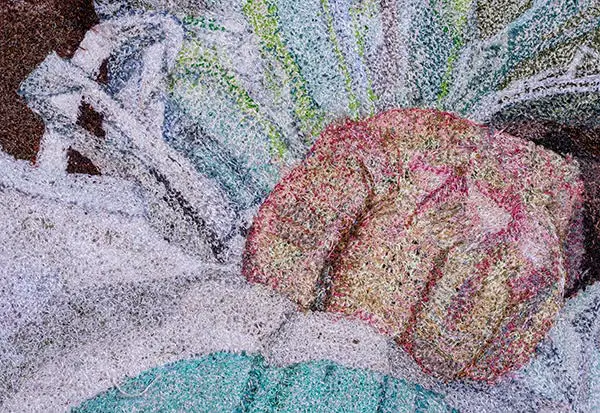
Image by Gould Photography.
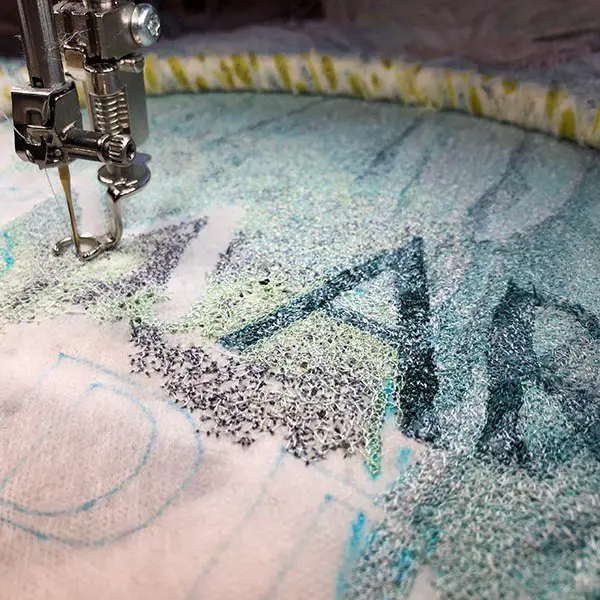
I was motivated to enter Hand and Lock because it is a prestigious, international competition for embroidery. I doubted my ability, I questioned my process and struggled with the accolade of being an embroiderer. Entering the prize might help me to find some answers to these questions and would allow the opportunity for the work to be viewed by people who are passionate about stitched textiles.
Are there any secrets you can now reveal about your entry?
A secret that I can now reveal about my entry, ‘A Couple on the Tube’, is that the drawing started because I needed to challenge a fear: portraiture. At university I had been told to never draw people, but I love the human form, the discussion of emotions between the sitter and the viewer, and I could not resist trying. I never expected the embroidered drawing to work and, on several occasions, I came close to giving up, but thankfully my obstinacy carried me through to the end.
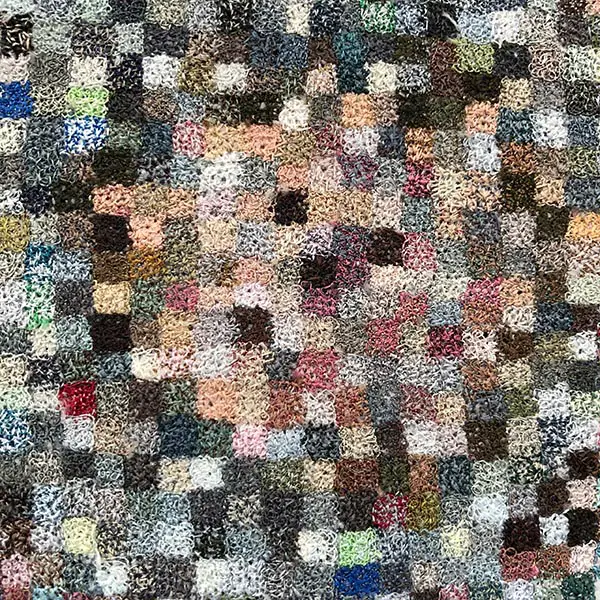
Past
Tell us about your background and how it led you to where you are.
My background story is both sad and happy. In 2009 I was widowed through suicide. The loss was traumatic, heart breaking and catastrophic for our family life. My sons were 10 and 8 years old and we all had to learn how to live again.
I explored my traumatic loss through art. In 2010 I started a Creative Arts Degree at Bath Spa. At first, I was very lost as I tried several different mediums hoping to be inspired and lose myself in the process of making. I tried drawing some of my late husband’s possessions with pencil on paper, but I was told that the work was not very good and that I should not draw again and especially, not to draw people.
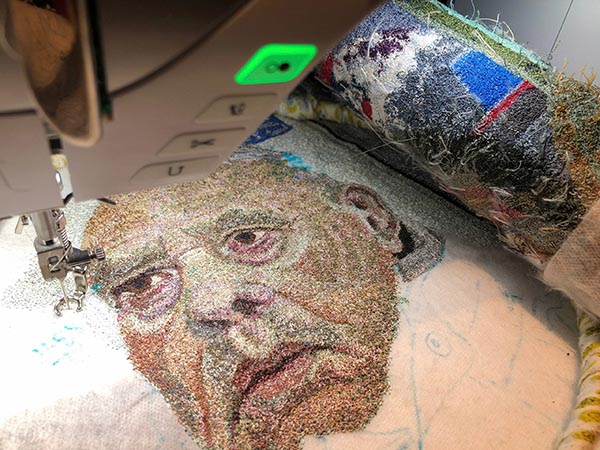
The comments were deflating. I loved to draw so I decided to find other ways to make it work. I turned to a child-hood love, my sewing machine and started to make drawings where I would not correct any of the mistakes. I experimented with different fabrics and threads before moving on to dissolvable fabric. The early results were experimental, and I learnt through making mistakes. The break-through moment came when I started to draw my late husband’s camera with rayon thread on dissolvable fabric.
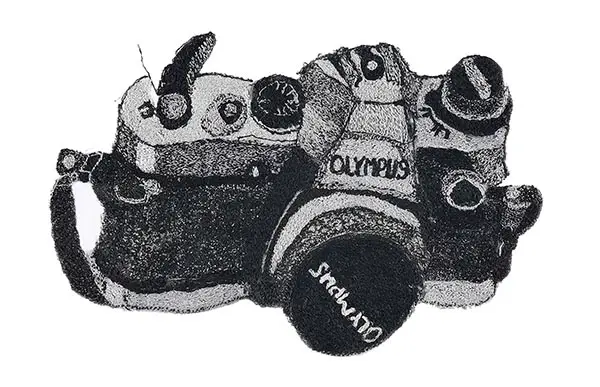
The process was tricky and time consuming, but incredibly engaging and this time I was encouraged by a tutor to finish it. The completed drawing was washed to remove the dissolvable fabric, the threads moved around and found their own place allowing the errors to show. At first, I couldn’t
decide whether or not to repair the mistakes but after a few days I realised that I loved the organic nature of the drawing. I had tried to make it perfect but the mistakes showed and that made the drawing work. I called the finished drawing “We should smile more…” and entered it to ‘Drawn’, a biannual competition held at The Royal West of England Academy, winning a scholarship for drawing.
Encouraged by this success, I needed to discover if I could go larger. What would happen if the drawing was more complex and the hours of stitching considerably greater? How would I feel if the drawing went wrong when I washed away the dissolvable fabric in the final stage of the making? To challenge this idea, I decided to draw a full-sized car engine. The stitched
drawing took over 350 hours to complete and it was successful. The strong masculine image made with a delicate feminine art form was titled ‘The Bristol 2 Litre Engine’ and sold at The Royal Academy’s Summer Exhibition in 2018.
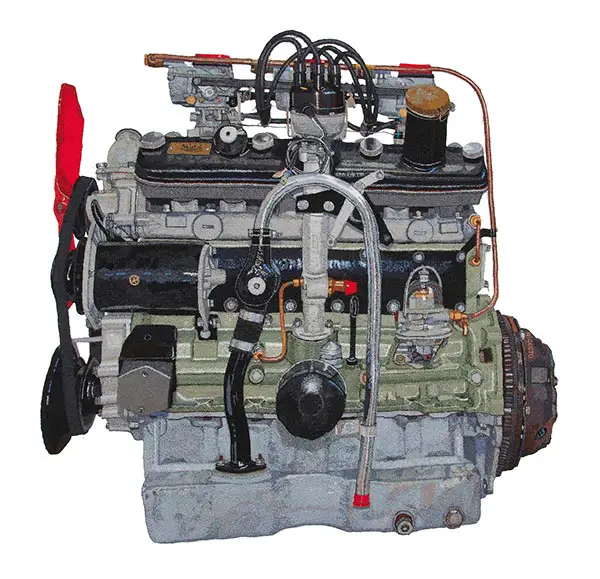
Present
My job in The Funk Files is to interview “pioneers on the embroidery frontier.” That’s you! What is the embroidery frontier, and what does it mean to be a pioneer here?
Embroidery is exciting, it is a delicate feminine art form that has the ability to engage audiences in powerful conversations. I make embroidered drawings of subjects that are completely unexpected for the medium such as masculine car engines and tools to portraiture that comments on every-day life. I continuously try to push the boundaries of my work as I challenge myself to make bigger and more complex embroidered drawings.
What’s been the biggest surprise of your career and the projects you’ve undertaken?
I am continuously surprised by a process that I have learnt through experimentation and I am very excited about my future in stitch.
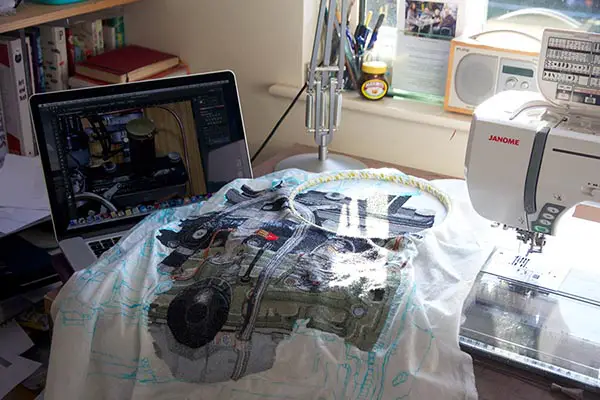
Future
What projects are on the horizon for you?
The future feels very exciting because I am due to retire next year after 35 years in the NHS. I plan to start an MA using research to help me question and challenge my practice so that I discover new ways to work with stitch. However, before I do that, I have to finish a very sensitive embroidered drawing of my dad. The photograph was taken as he looked to at his grandsons from his chair. He was ill and I promised to draw him in stitch.
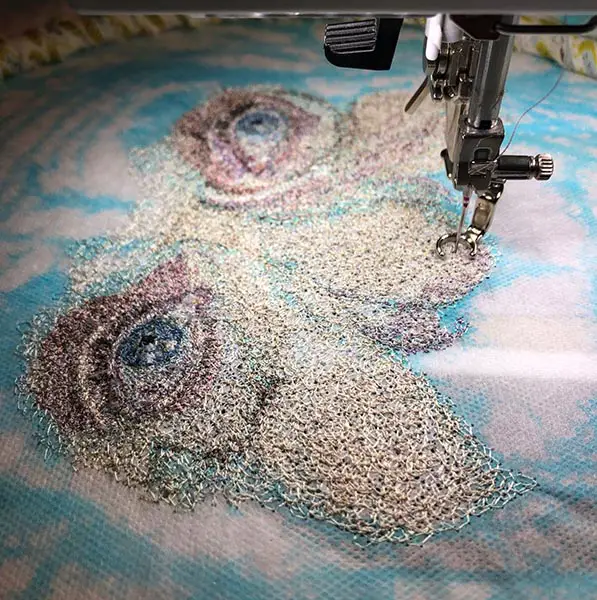
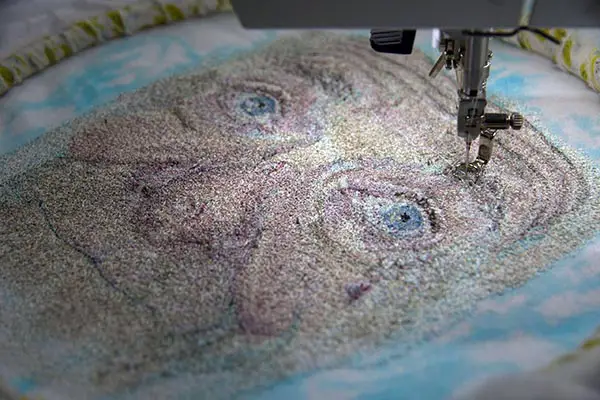
Tip
What one piece of advice would you offer someone looking to expand his/her embroidery skills?
I haven’t been taught how to embroider, I have followed my instinct and challenged my fears, listening to critical advice and absorbing encouragement from tutors, family and friends. Mistakes have happened and I learnt from them and we can all do that.
Rapid-fire Round: (Don’t think too hard about these.)
You can work with just one color for the next year—beads, thread, fabrics, everything. What color do you choose? Red. The colour imbues a whole range of emotions from anger and fire to love and passion. I believe that this sums up my work and life. I learnt to stitch because I had had to find a way to manage the dreadful feelings of hurt and loss after death through suicide. I examined my feelings as I noticed parallels between my work and my life. I fell in love with a process that took me to ‘The Royal Academy’s Summer Exhibition’ in 2018 and there I shared the achievement with friends and family who had witnessed our family’s despair turning in to hope.
What stitchable motif would you choose to represent you and your life? A pebble. I love the beach and really enjoy the sound of pebbles crunching
together under your feet as you walk along the shore finding your place to sit. Individually they are tactile with a calming beauty that beguiles their tumultuous history. Together, they form a strong, determined coast that defines our shores. As a human being, we are the person that we are because of the things that have happened to us in our lives. We don’t
always end up where we planned but we are all needed by the by the loved ones that surround us.
We’re sending a collection of art into space with the hope that aliens will someday discover it. You’re asked to contribute a piece of embroidery. What do you make and why? I would make an embroidered 3D animal cage. The delicate stitched cage with a broken door would represent the harm we are causing when we mess with biodiversity. I am writing this following the news about the farmed mink in Denmark and the mutation of the Covid 19 virus.
A book you enjoyed recently: Currently I am reading The Body Keeps the Score by Bessel van der Kolk. I am fascinated by the effects of trauma on the body. Throughout our lives, events happen, some are good, and some are bad. The body stores these happenings in its subconscious mind until we unlock them, work with them and discover how to heal our soul.
You must include something edible in your next piece. What do you use, and how do you incorporate it? To date, all images that I have chosen to work with have been unusual so trying to decide on a food feels difficult. However, if there was one that I might consider it would be a sweet potato. From the outside they are uninspiring, dirty and a funny shape, but inside is a nutritious, sweet delicious flesh. I love art that is unexpected and that is the same for the sweet potato.
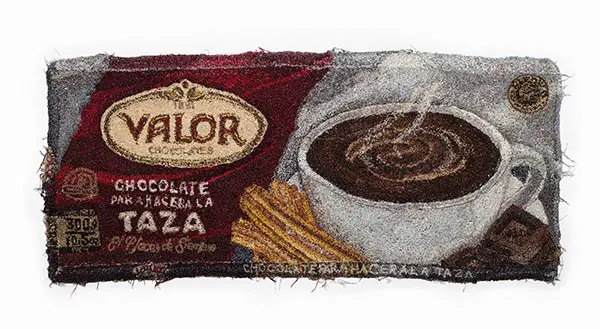
If you were not an artist, what would you be? I do actually work for the NHS but if I wasn’t doing that or being an artist then I would be a baker. I love baking because you start with some very basic ingredients and simple rules that you follow with great care and attention to deliver a food that delights all the senses.
You must create a textile for an animal. What is the animal, and what do you create? I don’t normally draw cute or pretty things but after the difficult year that we have all had, I was able to choose something decorative. During the lockdowns, we have really enjoyed the beautiful garden birds that have been feasting off of our bird feeders. To celebrate and say thank you to the blue tits, goldfinches, long tail tits, great tits and our resident robin, I would make some small, colourful, free machine embroidered bunting to drape between the feeders.
Describe your dream commission. What and for whom is it? My dream commission would be to produce either a large embroidered drawing or a body of work that discusses the economic and social implications for the widows of the executed World War One Soldiers. I would love to do this for The Imperial War Museum in London, a place that I have visited with my sons and late husband, Carl.
A studio is remaking a movie, and they want you to create a prop. What is the movie, and what prop are you creating? The movie is ‘It’s a Wonderful Life’. The prop, a beautiful embroidered badge with the words ‘I care about you’, for every important person in George Bailey’s life. Sometimes we all need reminding that simple words and deeds can have a beautiful effect on the emotional well-being of the people that we love.
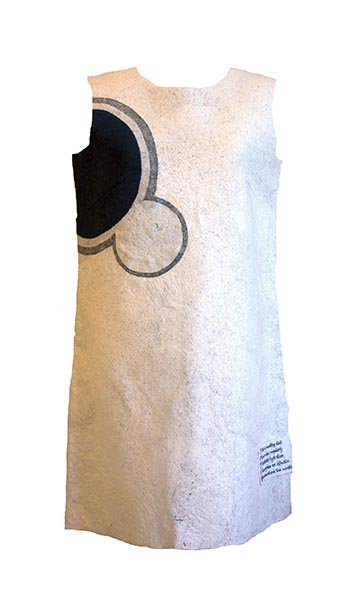
Thank you for sharing with us, Julie. You and your story are inspiring. I have enjoyed this immensely, and I know readers will feel the same. Stay in touch. We want to see what’s next for you!



